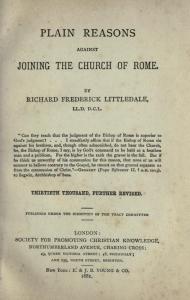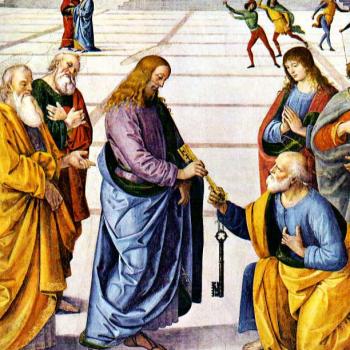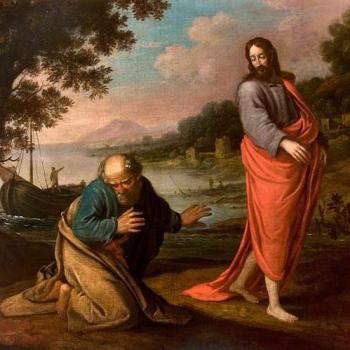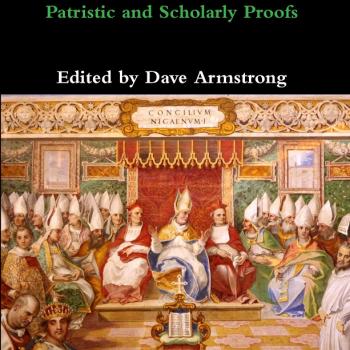“Please Hit ‘Subscribe’”! If you have received benefit from this or any of my other 4,600+ articles, please follow this blog by signing up (with your email address) on the sidebar to the right (you may have to scroll down a bit), above where there is an icon bar, “Sign Me Up!”: to receive notice when I post a new blog article. This is the equivalent of subscribing to a YouTube channel. Please also consider following me on Twitter / X and purchasing one or more of my 55 books. All of this helps me get more exposure, and (however little!) more income for my full-time apologetics work. Thanks so much and happy reading!
***
I am responding to the book, Plain Reasons Against Joining the Church of Rome (London: Society for Promoting Christian Knowledge, 1880), by Richard Frederick Littledale (1833-1890), an Anglo-Irish clergyman and prolific author. He received LL.B. and LL.D. degrees from Trinity College Dublin, in 1862, and a D.C.L. from Oxford. He was renowned as a father confessor, and next to Edward Pusey is said to have heard more confessions than any other priest of the church of England. His Plain Reasons Against Joining the Church of Rome, a volume of which thirty-six thousand copies were issued in 1880 and following years, evoked replies from the Rev. W. Horsfall, the Rev. A. Mills, Oxoniensis, and H. I. D. Ryder. I will be addressing certain of his claims regarding Peter and the Church fathers early in this book. His words will be in blue.
***
It is little more than a guess— though no doubt one with much in its favour — that St. Peter was ever at Rome at all; it is only a guess that he was ever Bishop of Rome, and for this there is very little evidence of any kind; it is only a guess that he had the power to appoint any heir to his special privilege, whatever that was; it is only a guess that he did so appoint the Bishops of Rome — and for these two guesses not the smallest scrap or tittle of evidence ever has been produced, or can be so much as reasonably supposed ever to have existed . . . the Ultramontane interpretation put on the three great texts in the Gospels which are relied on to support the ” Privilege of Peter,”— namely, St. Matt. xvi. 18, that St. Peter is the rock and foundation of the Church; St. Luke xxii. 31, 32, that St. Peter was infallible, and charged with guiding the faith of the other Apostles; and St. John xxi. 15- 17, that he was given jurisdiction over the Apostles and the whole Church — is contrary to the “unanimous consent of the Fathers,” who agree by a great majority that either Christ Himself, or St. Peter’s confession of Christ, is the rock and foundation of the Church . . . (pp. 25-26; my bolding)
St. Irenaeus (130-202) wrote:
2. Since, however, it would be very tedious, in such a volume as this, to reckon up the successions of all the Churches, we do put to confusion all those who, in whatever manner, whether by an evil self-pleasing, by vainglory, or by blindness and perverse opinion, assemble in unauthorized meetings; [we do this, I say,] by indicating that tradition derived from the apostles, of the very great, the very ancient, and universally known Church founded and organized at Rome by the two most glorious apostles, Peter and Paul; as also [by pointing out] the faith preached to men, which comes down to our time by means of the successions of the bishops. For it is a matter of necessity that every Church should agree with this Church, on account of its preeminent authority [potiorem principalitatem]. (Against Heresies, Bk. III, ch. 3, 2)
Tertullian (c. 160-c. 225) stated:
For this is the manner in which the apostolic churches transmit their registers: as the church of Smyrna, which records that Polycarp was placed therein by John; as also the church of Rome, which makes Clement to have been ordained in like manner by Peter. In exactly the same way the other churches likewise exhibit (their several worthies), whom, as having been appointed to their episcopal places by apostles, they regard as transmitters of the apostolic seed. (Prescription against Heretics, 32; c. 200)
The Ecclesiastical History, by Eusebius (c. 260/265-339) was the first and by far most important comprehensive history of the Church, and was completed in its first edition before 300 AD (later editions: c. 313-323):
After the martyrdom of Paul and of Peter, Linus [start of reign between 64-68] was the first to obtain the episcopate of the church at Rome. Paul mentions him, when writing to Timothy from Rome, in the salutation at the end of the epistle. [2 Tim 4:21] (EH, Bk III, 2, 1; cf. III, 4, 9. In Bk III, ch. 13, Eusebius says that Linus was bishop for twelve years)
Clement also, who was appointed third bishop of the church at Rome, was, as Paul testifies, his co-laborer [Phil 4:3] . . . (EH, Bk III, 4, 10)
In the second year of his reign, Linus, who had been bishop of the church of Rome for twelve years, delivered his office to Anencletus. (EH, Bk III, 13, 1)
In the twelfth year of the same reign [92/93] Clement succeeded Anencletus after the latter had been bishop of the church of Rome for twelve years. (EH, Bk III, 15, 1)
At that time Clement still ruled the church of Rome, being also the third that held the episcopate there after Paul and Peter. Linus was the first, and after him came Anencletus. (EH, Bk III, 21, 1-3)
Clement committed the episcopal government of the church of Rome to Evarestus, and departed this life after he had superintended the teaching of the divine word nine years in all. (EH, Bk III, 34, 1)
At that time also Alexander [r. c. 107-109 – c. 115-119], the fifth in the line of succession from Peter and Paul, received the episcopate at Rome, after Evarestus had held the office eight years. (EH, Bk IV, 1, 1-2)
Epiphanius (c. 315-403) wrote:
6 Paul even reached Spain, and Peter often visited Pontus and Bithynia. But after Clement had been appointed and declined, if this is what happened—I suspect this but cannot say it for certain—he could have been compelled to hold the episcopate in his turn, after the deaths of Linus and Cletus who were bishops for twelve years each after the death of Saints Peter and Paul in the twelfth year of Nero.) 7 In any case, the succession of the bishops at Rome runs in this order: Peter and Paul, Linus and Cletus, Clement, Evaristus, Alexander, Xystus, Telesphorus, Hyginus, Pius, and Anicetus, whom I mentioned above, on the list. And no one need be surprised at my listing each of the items so exactly; precise information is always given in this way. (Panarion 27.6.6-7)
Likewise, St. Jerome (c. 343-420) wrote:
Clement, of whom the apostle Paul writing to the Philippians says
With Clement and others of my fellow-workers whose names are written in the book of life,the fourth bishop of Rome after Peter, if indeed the second was Linus [d. c. 76] and the third Anacletus [d. c. 92], although most of the Latins think that Clement was second after the apostle. He wrote, on the part of the church of Rome, an especially valuable Letter to the church of the Corinthians, . . . (De Viris Illustribus, section 15)Hegesippus [c. 110-c. 180] who lived at a period not far from the Apostolic age, . . . says that he went to Rome in the time of Anicetus [d. 168], the tenth bishop after Peter, and continued there till the time of Eleutherius [d. 185 or 193], bishop of the same city, who had been formerly deacon under Anicetus. (De Viris Illustribus, section 22)
Simon Peter . . . himself chief of the apostles, after having been bishop of the church of Antioch . . . pushed on to Rome . . . and held the sacerdotal chair there for twenty-five years until the last, that is the fourteenth, year of Nero. (De Viris Illustribus [On Illustrious Men], section 1)
Regarding the confusion or mixed reports about the chronology of the earliest popes, see, “Pope St. Clement I” (Catholic Encyclopedia, John Chapman, 1908). He states, for example: “At the present time no critic doubts that Cletus, Anacletus, Anencletus, are the same person. Anacletus is a Latin error; Cletus is a shortened (and more Christian) form of Anencletus.”
Was Peter In Rome?
Tertullian, in The Demurrer Against the Heretics (A.D. 200), noted of Rome, “How happy is that church . . . where Peter endured a passion like that of the Lord, where Paul was crowned in a death like John’s [referring to John the Baptist, both he and Paul being beheaded].” Protestants admit Paul died in Rome, so the implication from Tertullian is that Peter also must have been there.
In the same book, Tertullian wrote that “this is the way in which the apostolic churches transmit their lists: like the church of the Smyrnaeans, which records that Polycarp was placed there by John; like the church of the Romans, where Clement was ordained by Peter.” This Clement, known as Clement of Rome, later would be the fourth pope. Clement wrote his Letter to the Corinthians perhaps before the year 70, just a few years after Peter and Paul were killed; in it he made reference to Peter ending his life where Paul ended his.
In his Letter to the Romans (A.D. 110), Ignatius of Antioch remarked that he could not command the Roman Christians the way Peter and Paul once did, such a comment making sense only if Peter had been a leader, if not the leader, of the church in Rome.
Irenaeus, in Against Heresies (A.D. 190), said that Matthew wrote his Gospel “while Peter and Paul were evangelizing in Rome and laying the foundation of the Church.” A few lines later he notes that Linus was named as Peter’s successor, that is, the second pope, and that next in line were Anacletus (also known as Cletus), and then Clement of Rome.
Clement of Alexandria wrote at the turn of the third century. A fragment of his work Sketches is preserved in Eusebius of Caesarea’s Ecclesiastical History, the first history of the Church. Clement wrote, “When Peter preached the word publicly at Rome, and declared the gospel by the Spirit, many who were present requested that Mark, who had been for a long time his follower and who remembered his sayings, should write down what had been proclaimed.”
Lactantius, in a treatise called The Death of the Persecutors, written around 318, noted that “When Nero was already reigning [Nero reigned from 54–68], Peter came to Rome, where, in virtue of the performance of certain miracles which he worked by that power of God which had been given to him, he converted many to righteousness and established a firm and steadfast temple to God.”
These citations could be multiplied. (Refer to Jurgens’ books or to the Catholic Answers tract Peter’s Roman Residency.) No ancient writer claimed Peter ended his life anywhere other than in Rome. (“Was Peter in Rome?,” Catholic Answers, 2004)
Eighteen Church Fathers Who Thought Peter was the Rock, the Foundation of the Church and its Leader, Based on Matthew 16
Tertullian, writing around 200-220, stated that “Peter . . . is called the Rock whereon the Church was to be built” (Prescription against Heretics, 22).
St. Hippolytus wrote around 225: “By this Spirit Peter spoke that blessed word, You are the Christ, the Son of the living God. By this Spirit the rock of the Church was established” (The Discourse on the Holy Theophany, 9).
Origen writing around 230-250, called Peter “that great foundation of the Church, and most solid rock, upon which Christ founded the Church” (In Exod. Hom. v. n. 4, tom. ii) and “Upon him (Peter) . . . the Church was founded” (In Epist. ad Rom. lib. v. c. 10, tom. iv) and “Peter upon whom is built Christ’s Church” (T. iv. In Joan. Tom. v.).
St. Cyprian, c. 246, wrote about “Peter, upon whom by the same Lord the Church had been built” (Epistle 54 to Cornelius, 7).
Firmilian, c. 254, wrote about “one Church, which was once first established by Christ on a Rock” (Inter Ep. S. Cyp. Ep. lxxv).
Aphraates (c. 336) stated that “the Lord . . . set him up as the foundation, called him the rock and structure of the Church” (Homily 7:15, De Paenitentibus).
St. Ephraem (c. 350-370) called Peter “the foundation of the holy Church” (Homilies 4:1).
St. Hilary of Poitiers in 360 held that Peter was “the foundation-stone of the Church” (On the Trinity, Bk. VI, 20).
St. Cyril of Jerusalem (c. 363), commenting on Matthew 16, calls peter “the foremost of the apostles and chief herald of the Church” (Catechetical Lecture 11, 3).
St. Optatus (c. 370), commenting on the same passage, wrote that Peter was “to be preferred before all the Apostles” and was “The Head of the Apostles” (De Schism. Don. l. vii. n. 3).
St. Gregory of Nazianzen (370) stated that Peter “is entrusted with the Foundations of the Church” (T. i. or. xxxii. n. 18).
St. Gregory of Nyssa (371) wrote that Peter was “the Head of the Apostles . . . (upon him) is the Church of God firmly established. . . . that unbroken and most firm Rock upon which the Lord built His Church” (Alt. Or. De S. Steph.).
St. Basil the Great (371) stated that Peter “received on himself the building of the Church” (Adversus Eunomius 2:4).
St. Epiphanius (c. 385): “upon which (Rock) the Church is in every way built . . . Foundation of the house of God” (Adv. Haeres.).
St. Ambrose (c. 385-389): “whom when He styles a Rock, He pointed out the Foundation of the Church” (T. ii. l. iv. De Fide, c. v. n. 56).
St. John Chrysostom (c. 387): “Head or Crown of the Apostles, the First in the Church . . . that unbroken Rock, that firm Foundation, the Great Apostle, the First of the disciples” (T. ii. Hom. iii. de Paenit. n. 4).
St. Jerome (385): “Peter, upon whom the Lord has founded the Church” (Letters 41, 2).
St. Cyril of Alexandria (424): “the church . . . over this he sets Peter as shepherd” (Comm. on Matt., ad. loc.).
Nine Church Fathers Who Thought That John 21 was “Papal”: Indicative of Peter Being the Leader of the Early Church
Origen (c. 216): “the Chief Authority as regards the feeding of the sheep was delivered to Peter” (T. iv. l. 5, in Ep. ad Rom. n. 1).
St. Cyprian (c. 246): “to the same [Peter] He says, after His resurrection, Feed my sheep.
And although to all the apostles, after His resurrection, He gives an equal power, . . . yet, that He might set forth unity, He arranged by His authority the origin of that unity, as beginning from one.” (Treatise 1: On the Unity of the Church, 4).
St. Ephraem (c. 350-370): “The Lord . . . delivered his flock to Simon . . . Three pledges he took from him as shepherd, that with love he should shepherd his lambs, and should visit his sheep with mercy, and should guard his ewes with fear.” (HVirg. 36, 6; CSCO 223, Syr. 94).
Ambrosiaster (c. 380-384): “After the Saviour all were included in Peter; for He constituted him to be their head, that he might be the shepherd of the Lord’s flock” (Quaest. 75, ex N. Test. in App. St. August. tom. iii. 2894).
St. Ambrose (385): Therefore did Christ also commit to Peter to feed His flock” (Ib. in. Ps. cxviii. [Mem] n. 3).
St. Epiphanius (c. 385): “He heard from the same God, ‘Peter, feed My lambs;’ to him was intrusted the flock; he leads the way admirably in the power of his own Master.” (Tom. ii. In Anchorat. n. 9).
St. John Chrysostom (c. 387): “He puts into his hands the presidency over the brethren . . . [and] says, ‘If Thou lovest Me, preside over the brethren’ . . . He sets the presidency over his own sheep . . . He appointed this man (Peter) teacher . . . of the world.” (In Joan. Hom. lxxxviii. n. 1, tom. viii.).
“What advantage, pray, could be greater than to be seen doing those things which Christ with his own lips declared to be proofs of love to Himself? For addressing the leader of the apostles He said, Peter, do you love me?
and when he confessed that he did, the Lord added, if you love me tend my sheep.
The Master asked the disciple if He was loved by him, not in order to get information (how should He who penetrates the hearts of all men?), but in order to teach us how great an interest He takes in the superintendence of these sheep. This being plain, it will likewise be manifest that a great and unspeakable reward will be reserved for him whose labors are concerned with these sheep, upon which Christ places such a high value. . . . For what purpose did He shed His blood? It was that He might win these sheep which He entrusted to Peter and his successors. . . . Will you, then, still contend that you were not rightly deceived, when you are about to superintend the things which belong to God, and are doing that which when Peter did the Lord said he should be able to surpass the rest of the apostles, for His words were, Peter, do you love me more than these?
. . . one is required to preside over the Church, and to be entrusted with the care of so many souls . . .” (On the Priesthood, Book II, 1-2)
St. Augustine (c. 400): “. . . the Lord commended his sheep to Peter himself to feed . . . when Christ speaks to one, unity is commended — and to Peter for the first time, because Peter is first among the apostles.” (Sermo. 295).
“[T]here are many other things which most justly keep me in her bosom. The consent of peoples and nations keeps me in the Church; so does her authority, inaugurated by miracles, nourished by hope, enlarged by love, established by age. The succession of priests keeps me, beginning from the very seat of the Apostle Peter, to whom the Lord, after His resurrection, gave it in charge to feed His sheep, down to the present episcopate. And so, lastly, does the name itself of Catholic, which, not without reason, amid so many heresies, the Church has thus retained; so that, though all heretics wish to be called Catholics, yet when a stranger asks where the Catholic Church meets, no heretic will venture to point to his own chapel or house.” (Against the Fundamental Epistle of Manichaeus, ch. 4, 5).
“The Lord, indeed, had told His disciples to carry a sword; but He did not tell them to use it. But that after this sin Peter should become a pastor of the Church was no more improper than that Moses, after smiting the Egyptian, should become the leader of the congregation.” (Contra Faustum, Book XXII, 70).
“And again the Lord asked this question, and a third time He asked it. And when he asserted in reply his love, He commended to him the flock. For each several time the Lord Jesus said to Peter, as he said, I love you;
Feed My lambs,
feed My little sheep.
In this one Peter was figured the unity of all pastors . . .” (Sermon 97 on the New Testament, 2).
“Peter generally stands for a figure of the Church.” (Sermon 25 on the New Testament, 10; cf. Sermon 96; Sermon 88, 4).
“For He says to Peter, in whom singly He forms the Church; Peter, do you love Me?
He answered, Lord, I do love You.
Feed My sheep.
” (Sermon 87 on the New Testament, 3).
St. Peter Chrysologus (432): “He commends His sheep to be fed by Peter, in His stead” (Serm. vi. In Ps. xcix).
For more on both passages, see: Papal Authority In The NT And The Fathers (Vs. Mike Winger) [3-9-24].
*
Practical Matters: Perhaps some of my 4,600+ free online articles (the most comprehensive “one-stop” Catholic apologetics site) or fifty-five books have helped you (by God’s grace) to decide to become Catholic or to return to the Church, or better understand some doctrines and why we believe them.
Or you may believe my work is worthy to support for the purpose of apologetics and evangelism in general. If so, please seriously consider a much-needed financial contribution. I’m always in need of more funds: especially monthly support. “The laborer is worthy of his wages” (1 Tim 5:18, NKJV). 1 December 2021 was my 20th anniversary as a full-time Catholic apologist, and February 2022 marked the 25th anniversary of my blog.
PayPal donations are the easiest: just send to my email address: [email protected]. Here’s also a second page to get to PayPal. You’ll see the term “Catholic Used Book Service”, which is my old side-business. To learn about the different methods of contributing (including Zelle), see my page: About Catholic Apologist Dave Armstrong / Donation Information. Thanks a million from the bottom of my heart!
*
***
Photo credit: Richard Frederick Littledale’s book, Plain Reasons Against Joining the Church of Rome; 1881 title page; from Internet Archive.
Summary: Anglican polemicist Richard Frederick Littledale (1833-1890) made dubious claims about patristic beliefs regarding St. Peter. I shoot them down with historical facts.














